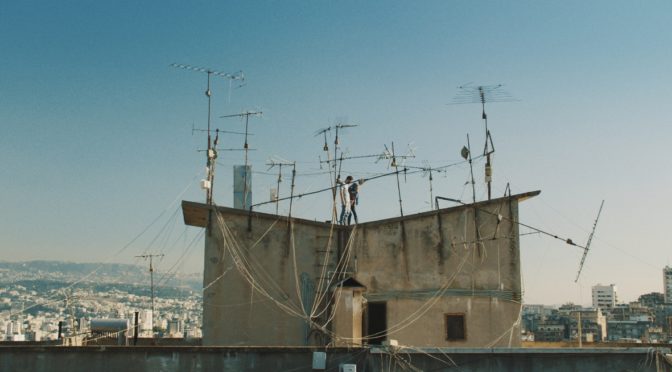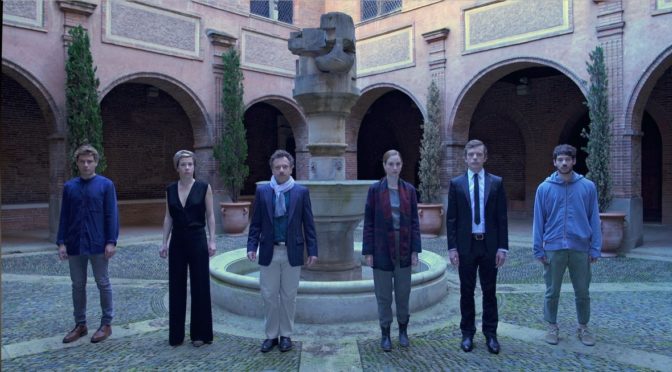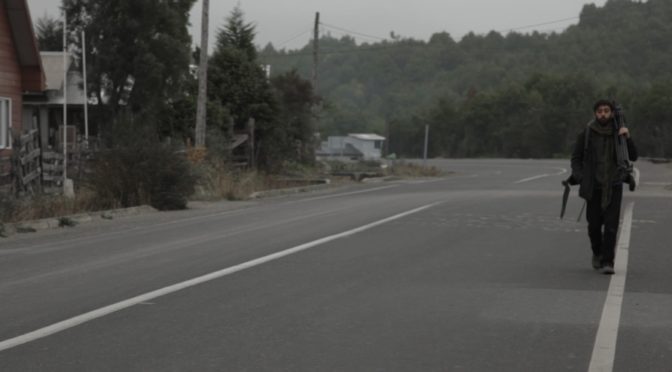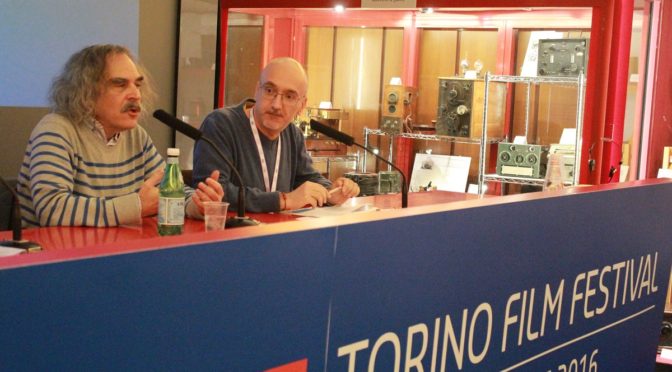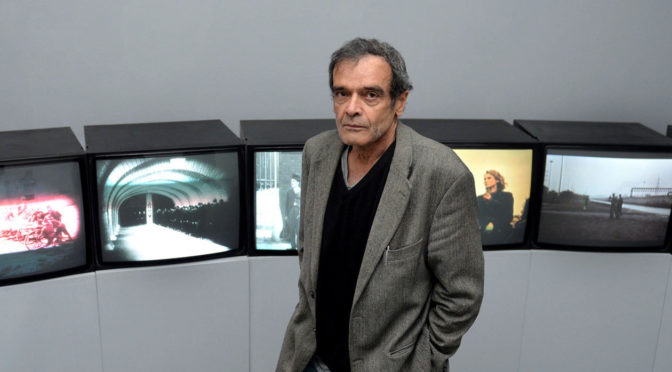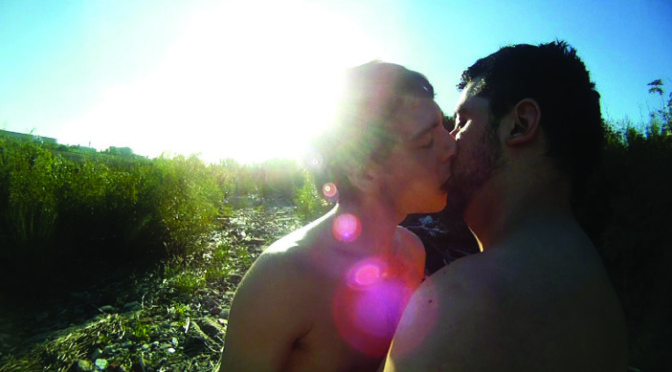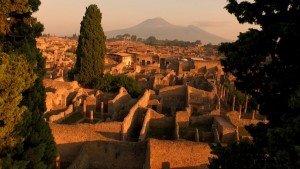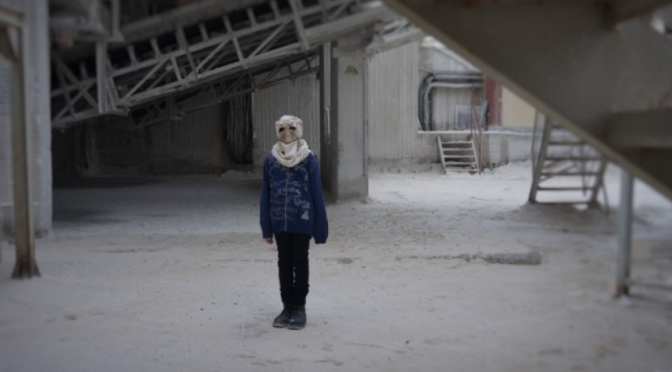Nella contemporaneità la comunicazione tra individui si riduce, nella maggior parte dei casi, ad un’interazione attraverso i mezzi digitali. Mezzi che veicolano informazioni in maniera compulsiva, mostrando allo spettatore situazioni e fatti di ogni genere. Il sensazionalismo ha assunto ormai sfumature più vaghe ed eterogenee: la notizia non è più rappresentata da un fatto di fondamentale importanza che tocca la società, e situazioni legate al quotidiano possono rivestire un ruolo sociale di primaria importanza.
Archivi tag: Onde
“Tshweesh” by Feyrouz Serhal
Versione inglese a cura del Master in Traduzione per il Cinema, la Televisione e l’Editoria Multimediale
Article by: Marco De Bartolomeo
Translation by: Federica Franzosi
In Brazil the start of the FIFA world cup is just minutes away and halfway around the world, in Beirut, people are getting ready for the big event. Fans are in a frenzy, flags are fluttering on the balconies and the voice of the Arabian commentator marks the passing of time.
Everything is ready when a strange interference jams the signal. Football fans runt to the roves to take the antennas down and then reassemble them, rotating, inclining, trying to get them in the right direction but to no avail. TV frequencies seem to be shielded.
“Tshweesh” di Feyrouz Serhal
In Brasile mancano pochi minuti all’inizio dei mondiali FIFA e dall’altra parte del mondo, a Beirut, fervono i preparativi per il grande evento. Gli appassionati sono in fibrillazione, sui balconi sventolano le bandiere e la voce del telecronista arabo scandisce il passare degli attimi.
È già tutto pronto, quando una strana interferenza disturba il segnale. I tifosi si precipitano sui tetti, smontano e rimontano le antenne, le ruotano, le inclinano, tentano di orientarle nella giusta direzione ma ogni sforzo è inutile. Le frequenze sembrano schermate.
“EN ATTENDANT LES BARBARES” by EUGÈNE GREEN
Versione inglese a cura del Master in Traduzione per il Cinema, la Televisione e l’Editoria Multimediale
Article by: Martina Bonfiglio
Translation by: Valeria Alfieri
En attendant les barbares is a simple, minimalistic movie that succeeds to deeply inspect the characters’ fears; fears that mirror those of most people in the modern world. It follows a fairy-tale journey, in which the present time is mixed with an indefinite time where wizards, knights and ghosts live.
The movie was created during a workshop involving a group of actor held by the director in Tolouse; this sense of genuine craftsmanship, of experimentation, is highlighted by the backstage photos shown at the beginning of the movie.
Continua la lettura di “EN ATTENDANT LES BARBARES” by EUGÈNE GREEN
“EN ATTENDANT LES BARBARES” DI EUGÈNE GREEN
Un film essenziale e minimale che riesce a indagare nel profondo le paure dei personaggi. Paure che rispecchiano i timori del mondo moderno. Un viaggio fiabesco, in cui la contemporaneità si mischia a un tempo non ben definito da cui riemergono maghi, cavalieri e fantasmi. En attendant les barbares nasce da un laboratorio con un gruppo di attori tenuto dal regista a Tolosa; e questo spirito di genuina artigianalità, di sperimentazione, viene sottolineato dalle foto di backstage mostrate all’inizio del film. Continua la lettura di “EN ATTENDANT LES BARBARES” DI EUGÈNE GREEN
“A WINDOW ON THE WORLD” by AXEL OHMAN
Versione inglese a cura del Master in Traduzione per il Cinema, la Televisione e l’Editoria Multimediale
Article by: Annagiulia Zoccarato
Translation by: Federica Franzosi
A Window on the Word: photography, in the end, is just that. It might be a personal shot or a photograph that has made history, but a photograph always shows and describes a small piece of world, that should not be necessarily true, but it still is a fragment of reality. And cinema is nothing but a series of moving photos, shots and snap-shots.
Continua la lettura di “A WINDOW ON THE WORLD” by AXEL OHMAN
“A WINDOW ON THE WORLD” di AXEL OHMAN
A Window on the World, una finestra sul mondo: in fondo la fotografia è proprio questo. Che si tratti di uno scatto personale o di una fotografia che ha fatto la storia, essa mostra e racconta sempre un piccolo pezzo di mondo, non necessariamente vero, ma pur sempre un frammento di realtà. E il cinema non è altro che una serie di fotografie, di scatti e di istantanee in movimento.
Continua la lettura di “A WINDOW ON THE WORLD” di AXEL OHMAN
“La madre, el hijo y la abuela” by Benjamín Brunet
Versione inglese a cura del Master in Traduzione per il Cinema, la Televisione e l’Editoria Multimediale
Article by: Annagiulia Zoccarato
Translation by: Federica Franzosi
The Onde section of the 35th Torino Film Festival includes among its titles a film that is as touching as it is delicate. La madre, el hijo y la abuela is the first feature film by the Chilean director Benjamín Brunet, which was filmed in the city of Chaitén after the eruption of the volcano with the same name. The movie is divided in three chapters, one for each character, and walks on the thin line between fiction and documentary.
Continua la lettura di “La madre, el hijo y la abuela” by Benjamín Brunet
“La madre, el hijo y la abuela” di Benjamín Brunet
La sezione Onde del trentacinquesimo Torino Film Festival vede tra i titoli che la compongono un’opera prima tanto emozionante quanto discreta. La madre, el hijo y la abuela è il primo lungometraggio del giovane regista cileno Benjamín Brunet che filma nella città di Chaitén dopo l’eruzione dell’omonimo vulcano. Articolato in tre capitoli come i propri personaggi, il film cammina sul sottile filo che separa fiction e documentario.
Continua la lettura di “La madre, el hijo y la abuela” di Benjamín Brunet
“LET THE SUMMER NEVER COME AGAIN” by ALEXANDRE KOBERDIZE
Versione inglese a cura del Master in Traduzione per il Cinema, la Televisione e l’Editoria Multimediale
Article by: Maria Cagnazzo
Translation by: Melissa Borgnino
A wind instrument played with uncertainty takes us into a blurred and just as uncertain world.
Let the Summer Never Come Again is entirely filmed with an old mobile phone, and the low quality of the images hits us with astounding force from the very beginning. The director is intentionally vague, forcing us to stay in the dark without clearly showing what is really going on. But we do not need to see well in order to understand the distress that pours out from every single sequence. This is the style of the author, which pervades the entire movie.
Continua la lettura di “LET THE SUMMER NEVER COME AGAIN” by ALEXANDRE KOBERDIZE
“LET THE SUMMER NEVER COME AGAIN” di ALEXANDRE KOBERDIZE
Uno strumento a fiato suonato con incertezza ci apre la porta di un mondo sfocato, anch’esso incerto.
Let the Summer Never Come Again è interamente girato con un cellulare di vecchia generazione e la scarsa qualità dell’immagine emerge fin dall’inizio in maniera imponente. Il regista ricerca l’imprecisione, e noi siamo costretti a non sapere, a non poter osservare pienamente ciò che ci viene mostrato. Non c’è bisogno di vedere bene per capire il disagio che trasuda da ogni sequenza: è questa la poetica di cui è intriso il film.
Continua la lettura di “LET THE SUMMER NEVER COME AGAIN” di ALEXANDRE KOBERDIZE
“Le fils de Joseph” di Eugène Green – Conferenza stampa
Si è svolta, nelle sedi Rai, la conferenza stampa di Le fils de Joseph di Eugène Green, presentato nella sezione “Onde” al 34° Torino Film Festival. Il regista si è reso disponibile a rispondere per mezz’ora alle molte domande e curiosità da parte dei giornalisti, mostrando inoltre la conoscenza dell’italiano quasi impeccabile. La storia narrata vuole essere foriera del messaggio che la comunicazione tra generazioni (tra padri e figli per esempio) è molto importante; il problema maggiore della civiltà di oggi, come afferma Green, è che la gente non vive più nel presente, ovvero nella realtà, ma in una dimensione sempre più virtuale. Questo tema influenza diversi lavori del regista.
Continua la lettura di “Le fils de Joseph” di Eugène Green – Conferenza stampa
Retrospettiva Harun Farocki
Cinque opere scelte all’interno della vastissima produzione del film-maker e teorico tedesco Harun Farocki mettono in questione il mondo delle immagini, i modi della loro produzione e l’uso all’interno della società contemporanea.
Pompei Eternal Emotion by Pappi Corsicato
Article by: Alessandro Arpa
Translation by: Cristiana Caffiero
Pompei Eternal Emotion is the new production by Pappi Corsicato. It’s a short cut which lasts about 10 minutes about Pompei, its archeological sites where we can find some bodies petrified by magma. The bodies of the tourists appear hibernated as well: they are puppets without life that turn into victims of the camera. In the several rooms there are some shells without soul. This short cut is really memorable….memorable is the right word to indicate it if we consider the disasters which have occurred in Pompei in 2014 which have destroyed an important part of our artistic heritage.
Anyway what will be next is even more amazing. After Corsicato’s movie, someone in the audience stands up to move away while those who are still inside the cinema are someway frightened by the movie that will follow. Maybe it’s just because of its title: Heterophobia. Just few brave ones among the audience have stayed. It’ s dark in the theatre. From the screen there’s a light arising towards the audience: Mariano who masturbates. Then some other people step out of the theatre. They looked disgusted by what they have just happened to watch on the screen: this is what it’s defined as self-righteousness. For about one minute Mariano is what we can call mechanical love. This is the way Heterophobia starts. It soon turns into an anti patriarchal rhapsody. Heterophobia is a movie directed by Goyo Anchou. Mariano is a young guy who has been raped. He represents a vile puppet of a kind of heterosexual illusion. He has to face the strong caste of society, which is represented by patriarchy according to the Argentinian director. Patriarchy rapes people with its rude aggression. The main character is a small part of the entire universe, a small being created by God who looks for a small place for himself in the world. Mariano denies himself: he just steps from one love to another, he’s not reciprocated and his fate is disillusion and frustration. He has a main relationship with an heterosexual who abandons him at the end. Mariano thinks that God doesn’t care about his creatures and suddenly turns into Satanist. He takes part into an initiation ceremony which is wonderfully described by the Argentinian director: Masonic and Cabalhistic symbols, images from movies such as Cabiria by Pastrone, Maciste in hell by Freda, Zasie dans le metro by Malle. This movie combines some quotes from classic movies as well as dreamlike, hypnotic images that hint to Kenneth Anger or Derek Jarman. After Un chant d’amour by Jean Genet, Heterophobia can be considered the new manifesto of the homosexual culture. Mariano understands that it’s a nonsense to look for happiness in other people or to be a frustrated heterosexual. He comes to understand that to accept oneself is the way to happiness and freedom. Now Mariano is happy with his new boyfriend. He has come to a safe rescue towards a future where homosexuality won’t be a taboo anymore, machismo will turn into nonsense and people will feel free to abolish the so called boring normality.
“Symptoma” di Angelos Frantzis
Dopo Into the Woods del 2010, Symptoma è il nuovo lavoro del regista greco Angelos Frantzis. A chi si avvicinasse solo adesso al cinema greco, questo film potrebbe risultare straniante, un groviglio in cui si disperdono onirismo e deliri concettuali. Il cinema greco contemporaneo è la meticolosa fusione di elementi fantastici, surrealistici e, a tratti, esoterici ma riesce raramente a plasmarli nella maniera corretta.
“TÔI QUÊN RÔI – I FORGOT!” and “LA HUELLA EN LA NIEBLA”: let’s let young international director have their chance
Article by: Alisa Marghella
Translation by: Giulia Magazzù
After Pude ver a puma, Eduardo Williams comes back to the TFF with another short film, Tôi quên rôi – I forgot!, which preceded the screening of The huella en la niebla.
With Tôi quên rôi – I forgot!, the young Argentine director proposes a longer film (maybe too long, since it had to precede the next film). It is a twenty-six minute movie that discontinuously portraits the anonymous lives of some guys who spend their days between work, hanging out and parkour. He portraits a fragmented generation, ready to jump from one roof to another, who lives in a suspended reality.
In the director’s words, «This film came to me as an opportunity to locate myself in the hypothetical place that I prefer when I direct or watch a movie, or far from any certainty. I always try to get lost in these experiences, in order to generate a vacuum that gives me the opportunity to exceed my limits». The picture that emerges is that of an unnerved and unnerving everyday life, exasperated by the use of hand-held cameras. The plot is too incomplete and the photography annoying, except for the last shot that clarifies to the viewer the sense of the fragmentary nature of the scenes.
La huella en la niebla is certainly a more pleasant movie. Directed by another Argentine director, Emiliano Grieco, it tells the story of Elias, a wounded man who returns to his island in order to rebuild his life. The wound, however, does not heal, and despite his efforts the fog ends up swallowing him.
Grieco does not employ a real actor, but a fisherman. He uses no dialogues at all, but water looks like the real star of the film. Considered as the conclusion of the documentary The Son of the River, the first work of the young director, this film lies somewhere between the great stories of Dickens and Conrad and documentary, making a good use of photography. The contrast between in focus and out of focus images serves as a narrative liaison, allowing the director to take advantage of the suggestions offered by the landscape to describe the emotions of a man trying (to no avail) to find traces of the past through the river. Overall, though, the narrative results are extremely “confusing” and the goal of placing the character in an interior limbo, unfortunately, leaves the viewer in that limbo too.
YOUNG BODIES HEAL QUICKLY, AN ATYPICAL ON THE ROAD FILM
Article by: Matteo Merlano
Translation by: Giulia Magazzù
American experiments ride along familiar roads. Filmmakers play with pre-existing genres, distorting, shrivelling and demolishing them. It is the case of this bizarre film by New Yorker director Andrew T. Betzer, which already been presented at the Tribeca Film Festival and has now landed in Turin in the Waves section. The film portraits the flight of two brothers (Gabriel Croft and Hale Lytle), guilty of the murder of a girl, through a disorienting and lost America, inhabited by freaks, nostalgic for the Reich and the war in Vietnam (as the bizarre character of an old “freak”).
Betzer depicts an unforgiving portrait of his country shot in a quite handcrafted way. ‘Young Bodies Heal Quickly’ shows us a lost and crazy version of the US, just like the two young protagonists who are running around the country without an existential reason. So far, the idea is interesting and the dirty and blurred photography conveys this alienating effect. Eventually, this style weighs and after the first hour, the story goes completely off the visual and editing rails. Experimenting does not mean raving and the impression we had leaving the cinema is that in several parts Young Bodies Heal Quickly got lost, dragging the viewer in this disorientation. The final climax is too long and dispersive and putting an explicit sex scene (cameo by Josephine Decker that, after the short film Violent Madonna Mia seems to take taste in expression of sexuality explicit) does not help the audience in finding his soothed attention.
Generally, the film is an interesting experiment and visual exploration of a possible new language of American independent cinema. It is always of Seventh Art, which requires implementing every available form. Maybe a little storytelling would not hurt, in a time when the real experiment is perhaps the tale. “But that’s another story”, quote.
PRIKLYUCHENIE – (ADVENTURE) IN THE MONOTONY OF THE “WHITE NIGHTS”
Article by: Alisa Marghella
Translation by: Carla Cristina Loddo
The eggs for breakfast, the sound of the wind chimes when exiting the house, the tea preparation, the naps on the three chairs during the work shift… All these things mark the days for Marat, a young security watchman. In “Priklyuchenie – Adventure” there’s very little adventure: the events in the shy watchman’s life recur in a routine marked by few images, useful for understanding his loneliness
Continua la lettura di PRIKLYUCHENIE – (ADVENTURE) IN THE MONOTONY OF THE “WHITE NIGHTS”


